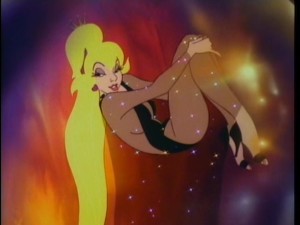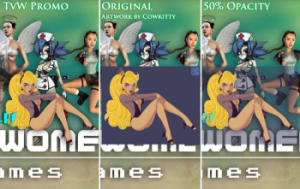A recent controversy within online gaming community involves the video blogger Anita Sarkeesian and her video series “Tropes vs. Women in Video Games.” Sarkeesian’s video critiques the portrayal of women in video games and related media. However, this controversy is particularly interesting because it involves a claim of copyright infringement.
In the video and promotional materials for the series, Sarkeesian used an image of “Princess Daphne” from the game Dragon’s Lair. The “official” depiction of Daphne in Dragon’s Lair looks like this:
Sarkeesian promoted her “Tropes vs. Women in Video Games” series with a collage of female video game characters including Princess Daphne. However, Sarkeesian used an image of Daphne pulled not from Dragon’s Lair, but rather from the page of a fan artist named “Tammy” from CowKitty.net. Sarkeesian’s promotional materials featured Tammy’s artwork with her gray background and artist signature removed, as seen below:
Tammy was upset that her work was used without her permission, and threatened to sue Sarkeesian’s company, Feminist Frequency. Sarkeesian and her lawyers responded by claiming that a “remixed collage is transformative in nature and as such constitutes a fair use of any copyrighted material as provided for under section 107 of the US Copyright law.” Allegations started to fly, and Feminist Frequency was challenged as not being a legitimate non-profit.
I think Sarkeesian is in the right, at least with respect to the copyright issue. As much as it’s obvious that she could have saved herself a lot of trouble by asking Tammy’s permission first, it’s clear to me that if Tammy were to succeed on her copyright claim, it would set a disastrous precedent for future Fair Use cases.
First off: Tammy did not create the character of Princess Daphne. The character was created for the game Dragon’s Lair and is presumably owned by Cinematronics, Don Bluth or some other entity associated with the game. Tammy’s fan art is an unauthorized derivative work, and is likely infringing on Cinematronics’ copyright with no real fair use defense (while the pose and coloring is slightly different, Tammy’s version deviates very little from the original character design seen above and is unlikely to be seen as transformative). Under 17 U.S.C. § 103(a), “protection for a work employing preexisting material in which copyright subsists does not extend to any part of the work in which such material has been used unlawfully.” Tammy’s fan art relies entirely on the existing Princess Daphne model and doesn’t create any original contributions that are not infringing the original design. Therefore, Tammy’s fanart is ineligible for copyright protection under §103(a), and Sarkeesian may copy it at will.
We could stop the copyright analysis right there. But where’s the fun in that?
Let’s imagine a hypothetical that all the relevant assets related to Princess Daphne were in the public domain. Under this hypothetical, Tammy’s work is not infringing, and therefore Tammy has some copyrightable interest in her fan art. Clearly, Sarkeesian’s work contains a substantial similarity to Tammy’s work – it’s a clear copy-paste job. Now we get to the really interesting question: whether Sarkeesian’s use of Tammy’s fan art qualifies as a Fair Use.
As an initial matter, whether or not Feminist Frequency is non-profit is largely a red herring – whether a work is made for profit isn’t dispositive of the issue of Fair Use, as was held by the Supreme Court in the 2 Live Crew case. It is relevant, but I think some commentators, including Tammy herself, have overstated its importance. The real issue is how “transformative” Sarkeesian’s use is.
It is undisputed that under the doctrine of Fair Use, the “use of a copyrighted work . . . for purposes such as criticism, comment, news reporting, teaching . . . scholarship, or research, is not an infringement of copyright.” In other words, you can appropriate someone else’s work in order to publicly critique it. Sarkeesian has an indisputable right to post Tammy’s art in order to draw attention to its flaws. However here is the wrinkle: was Sarkeesian commenting on the flaws in Tammy’s work, or was Sarkeesian using Tammy’s work without comment in order to critique the portrayal of women in games generally? The distinction might mean all the difference in a Fair Use analysis.
In Campbell, the Supreme Court drew a line between “parody,” which is the “use of some elements of a prior author’s composition to create a new one that, at least in part, comments on that author’s work,” and “satire,” which uses the original to comment on or criticize something else. Parody is inherently transformative and very likely to be a fair use, whereas satire is less likely – but not impossible – to qualify.
Tammy could argue that Sarkeesian’s use of the Princess Daphne image is unprotected satire, not parody – Tammy would argue Sarkeesian appropriated her image of Princess Daphne not to comment on the aesthetic quality of the fan art itself, but rather to draw attention to her critique on something else (the portrayal of women in games, or perhaps the work of Don Bluth, whose team crafted the original design for Princess Daphne). On the other hand, Sarkeesian would argue that her right to critique Tammy’s “work” includes not only the right to critique the work’s aesthetic qualities, but also to critique and comment on the themes, characters and underlying ideas that it expresses.
So who is right? Does the author’s “work” include the underlying themes, motifs, and characters that comprise the work, or does the “work” include only those elements of the work that are entitled to copyright protection? Of course, it’s widely understood that copyright doesn’t apply to ideas, only the expression of those ideas. So does that mean that the right under Fair Use to critique a work applies only to critiques of the expression of an idea, and not the underlying idea itself?
If Tammy is correct, then Sarkeesian may only rely on Fair Use to protect her use of Tammy’s artwork if the “critique” is directed at Tammy’s own creative contributions, i.e., the elements of her image that she can claim as her copyrighted “work.” However, Tammy’s reading of Fair Use is dangerously narrow, and leads to absurd results.
Imagine a world where you can only use a piece of copyrighted media legally to comment on the quality of the media itself. Sure, movie reviews would survive unscathed – you could still use a movie clip to critique the movie’s quality. But what about other socially valuable uses? What if a law professor wanted to use a clip of 12 Angry Men to talk about the jury system in America? Under Tammy’s reading of Fair Use, this would be copyright infringement unless he was commenting on the quality of 12 Angry Men itself. Or, what about me? I posted Tammy’s art above in this post to demonstrate a legal controversy, not to comment or critique on the aesthetic contributions of Tammy’s work. Should I be held liable to Tammy as an infringer?
Or, if you don’t care about hypothetical law professors, what about reaction .gifs? Under Tammy’s argument, I could not legally post a copyrighted image of Kristen Wiig being angry to express my displeasure at Obamacare, because I would be commenting on Obamacare, not Kristen Wiig. Online .gifs “are the alphabet of internet culture.” It would seriously threaten the Internet’s unique communication structure if users constantly had to worry about whether or not their posting of hundreds of copyrighted images left them liable for hundreds of thousands of dollars.
Sarkeesian should be able to comment on pop culture using all the pop culture materials at her disposal. Sarkeesian’s show critiques the depiction of women in both games and game-related media within pop-culture at large. This necessarily includes a discussion of the portrayal of women in game-related fan art, and yes, Tammy’s piece as well. Although Tammy should be entitled to credit for her image – under the theory that the public will be likely be confused as to the source of the art otherwise – Tammy’s rights should not allow her to limit the scope of appropriate discourse about the broader social themes and implications inherent in her work.
Joe Newman is Legal and Policy Fellow at The Future of Privacy Forum.






RT @LaurenDShinn: Sarkeesian and Copyright: Testing the Boundaries of ‘Transformative’ Fair Use in Online Critique http://t.co/Yu8W6rShB9 …
Sarkeesian and Copyright: Testing the Boundaries of ‘Transformative’ Fair Use in Online Critique http://t.co/Yu8W6rShB9 via @CardozoAELJ